
Argon lasers are typically blue or green with 488-514nm wavelengths. As an ion gas laser, argon requires high voltages for excitation. Argon lasers were among the first laser types adapted for teeth whitening procedures. The chromophores’ visible green or blue light is well absorbed in stain molecules, facilitating the photochemical reaction that breaks down discoloration in the dental enamel. While effective at stain removal, argon lasers can increase tooth sensitivity during treatment.
Diode Lasers
As a dentist performing whitening services in Toronto, diode lasers utilize a semiconductor medium to generate laser light, typically with a red visible wavelength between 640-665nm. The compact size of diode laser wands allows for easier manipulation around the teeth during whitening treatments. Most at-home whitening kits incorporate an LED light source instead of an actual laser. LEDs use less energy and reduce the heat and tingling side effects sometimes associated with laser whitening sessions. While LED devices are gentler, diode lasers remain the gold standard light therapy for the most dramatic in-office whitening results.
Nd: YAG Lasers
Nd: YAG dental lasers utilize a neodymium-doped yttrium aluminum garnet crystal medium to produce light at a near-infrared wavelength of 1064nm. Operating in the invisible spectrum, Nd: YAG lasers provide deeper energy penetration to interact with chromophores in the stain molecules inside the tooth structure. However, lacking the visible light that helps activate and catalyze peroxide gels during treatment, Nd: YAG lasers alone show limited efficacy for teeth whitening unless the associate wavelength is frequency-doubled to produce visible green light at 532nm instead.
CO2 Lasers
CO2 lasers produce highly focused infrared light beams using electricity to excite carbon dioxide gas. With a longer wavelength between 9000-11,000nm, CO2 lasers operate in the far infrared zone of the electromagnetic spectrum. These industrial workhorse lasers have extensive applications for cutting and removing biological tissues. In dentistry, CO2 lasers can remove tooth decay and prep tooth surfaces for fillings. However, due to the high absorbency of hydroxyapatite that makes up the enamel structure, CO2 lasers provide little benefit for teeth whitening procedures and are not traditionally used for cosmetic bleaching techniques.
Er: YAG Lasers
LikeNd: YAG lasers, erbium-doped yttrium aluminum garnet (Er: YAG) lasers utilize a doped crystal medium to generate a precise beam with a wavelength of 2940nm. This puts Er: YAG lasers in the mid-infrared zone, leading to high absorption in both water and hydroxyapatite. While this can help ablate tooth enamel during cavity preparations and caries removal, it also limits transmitted energy for interaction with deeper stain molecules. However, the thermal interaction can heat enamel slightly, augmenting the diffusion of peroxide into pores for better whitening efficacy. With a reduced risk of heat damage, Er: YAG lasers with visible green wavelength targeting may assist whitening treatments.
Safety Concerns
As medical devices, any lasers used in clinical teeth whitening should adhere to governmental regulations and safety protocols. Potential risks from optical radiation include thermal injury and photochemical reactions that could damage the pulp or other oral tissues during treatment. Wearing specific glasses can filter certain wavelengths to protect eyes from laser irradiation. Maintaining light exposure levels below thresholds designated for the cornea and retina is vital for patient safety. Laser parameters, beam profiles, irradiation times, and associated bleaching chemistry all contribute to the intricacies of effective clinical teeth whitening.






